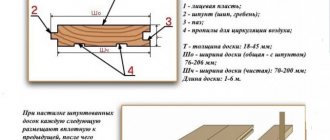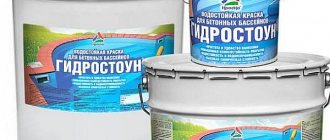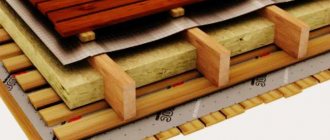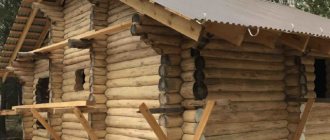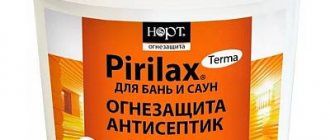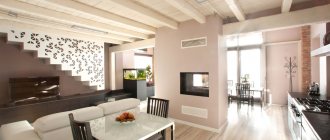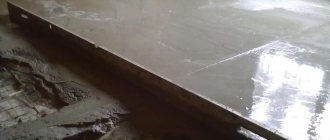Practice shows that in ANY house or bathhouse there are places or structures for the manufacture of which it is desirable to use wood species that are particularly resistant to decay. Usually these are FLOORS in the house, floors of open vernades, terrace boards, boards on an open or closed veranda under a canopy or deck boards, solid wood floor boards used in wet places, near swimming pools, in baths, steam rooms, saunas, etc. To reduce the risk of damage to the floorboard and extend the time of effective operation of the floor from the moment it is laid to the renewal of the floor covering, it is possible and recommended to use larch boards and floors. Larch wood is particularly resistant to damage from moisture and does not rot for a long time. It is even used to make a lining beam, a lining board or the lower crowns of a wooden house, on which a frame made of pine, fir, aspen, etc. is laid. But having chosen larch as a building material or made floors from larch, we may be faced with the task of selecting a finishing protective impregnation for a given type of wood, that is, how to paint and treat the larch floor. The thing is that it is difficult to apply varnishes and paints to larch wood and lumber due to its specific properties - natural oiliness, which prevents the “sticking” of surface paints and varnishes and quite high friability, which affects the degree of change in the geometry of the board when humidity changes treated wooden surface. Ordinary varnishes and paints practically DO NOT last on larch floorboards, or the protective coating treated with varnish and paint for wood on larch turns out to be NOT durable at all. It is safer to treat larch floors with impregnation, which does not peel off, does not form a hard surface film, but protects the wood from moisture and allows the wood to “breathe”, i.e. OIL and WAX.
What is rotting, what impregnations protect against it?
One of the reasons why we found it necessary to write this review was the widespread illiteracy of people writing about wood rot and means of protection against it. You read such rare nonsense that you become scared - what if in other areas where you don’t understand, they just as cheerfully tell you nonsense?
Composition for baths 2.7 l. Saunasuoya soup for protection against moisture and dirt. Banka Photos
In general, most of us think that rotting is caused by bacteria. This is true of a variety of protein flesh. It is decomposed by aerobic and anaerobic bacteria (those that need oxygen for life and those that do not). But wood is not so malleable. To decompose it, nature used not only bacteria (yes, there is bacterial rot), but also fungi. Fungi, more often than bacteria, cause wood rot, that is, its decomposition into simpler components.
Fungi that cause rot are not the only ones you need to protect against. In addition to them, there are also molds . They have little effect on the strength of wood, because they feed on substances dissolved in intracellular water, which their hyphae reach through various tubules on the wooden surface, practically without damaging the cell walls.
Mold is harmful due to its toxins and spores. Toxins are harmful if eaten - as some do when they cut off the moldy side of an apple, considering the rest healthy, but not realizing that the visible mold is its fruiting body, and the hyphae penetrate the entire apple. But we don't eat the tree, so spores are the main type of damage caused by mold growing on the tree.
spores in the air, they cover objects, but are activated only in the presence of moisture. In normal concentrations, our body copes with spores that penetrate it. But when there is a colony of mold in residential or bathing areas, the concentration of spores grows so much that this becomes the cause of mycotoxicosis, allergies and many diseases that at first glance cannot be associated with mold at all - migraines and heart disease, otitis media, rhinitis, bronchitis , etc. .P.
IMPORTANT! You shouldn’t believe Wikipedia that mold destroys wood, but you should definitely be afraid of it and fight it. It is also necessary to distinguish between rot and mold, because the means of combating them are different.
The third type of fungi that live in wood are staining fungi, such as blue fungi. Staining fungi, like mold, do not affect the strength of wood. Unlike mold, they do not harm humans. People just don't like their stained wood for aesthetic reasons, and they can also be a precursor to rot infection. We won’t say anything about the latter; such information came across only once and not in a scientific publication, but we took note of it. That is, it is also worth fighting staining fungi.
The very mechanism of wood destruction by fungi boils down to the fact that their hyphae eat away cell walls with enzymes, leading to their corrosion or destruction (they differ in the scale of dissolution - in the first case, holes are formed in the cell walls, in the second the walls dissolve entirely). The contents of the cells become stained, which leads to the darkening of rotting wood.
There are quite a few types of fungi that cause rotting, and they belong to different classes. Therefore, substances that successfully cope with some types are useless against others.
ATTENTION! There is no universal fungicide. Only compositions are possible that complement each other, affecting species over which the other has no control. But we have not found a single ready-made product that would work in this way. Only fungicides with limited spectrums of action are commercially available.
But what’s even sadder is that many fungicides that are sold specifically for baths are effective only against molds and staining fungi! And they sell them as a remedy for rot, taking advantage of the general illiteracy of buyers.
Why is that? Yes, because remedies for mold and staining fungi are simple antiseptic impregnations based on boron or chlorine. But the real remedies against rot are high-tech chemicals , expensive and imported. We simply have no other explanation. And that is why you will almost never see the composition on the label. The most you can count on is a streamlined statement that the composition contains “highly active biocides” or that the product “does not contain heavy metal salts.”
ADVICE! If you want something effective, look for imported products with clearly stated ingredients on the label and expensive ones.
Get rid of mold once and for all!
Having spent a lot of effort, energy, and money fighting this rot, you are not immune from mold appearing again; you need to eliminate the cause of the formation. The main thing in this fight, in our opinion, is to dry the entire bathhouse well; our article on proper ventilation in the bathhouse will help with this. After reading this, you will understand how to defeat the fungus. On my own behalf, I would like to add some useful tips:
- If your stove is not brick, but iron, then give it a good supply of air, then, always, after taking bath procedures, close the ash pan or the stove vent, throw in a few logs of firewood and let it work in low mode. So that the bathhouse dries out little by little from the inside!
- When heating the oven, you need to take care of excess moisture. Open all doors except the outside one and crack the window (if there is one) in the room farthest from the stove. Then the stove, when heating, will create a slight movement of air, and moisture from the entire bath will evaporate out the window or specially made ventilation.
- There are also several types of fungus and places where it appears. If fungus forms in the corners, it means that the stove most likely cannot cope with fully heating the bath. To do this, we recommend installing an additional heater; you can set a timer on it and finish drying the bath for 2-3 hours after the bath procedures. If fungus forms in the grooves of a log house, then perhaps it is poorly caulked and street air blows in, which, when heated, condenses on the log, and that’s where the fungus appears. If the fungus is at a height of 30-50 cm from the floor, then most likely you are poorly ventilating the room; proper ventilation will be enough here.
- Do not forget in the summer, if possible, to open the doors and windows in the bathhouse more often for good ventilation. Then your bathhouse will delight you with its appearance and quality for many decades!
Useful information: Did you know that bathhouses used to be heated black, carbon monoxide smoke was distributed throughout the room, killing all microbes. The bathhouse was as sterile as a surgery. People came to the bathhouse to give birth to children!
The material written here is based on years of accumulated experience. Below are photos of fungus with an underheated oven. The issue was resolved after installing additional heaters in the Washroom and Relaxation Room.
Have fun!
In different rooms
How do different sauna rooms differ from each other? The amount of water falling on the floor. There is more washing water on the floor. In the steam room... if it is a sauna, then there will be little water, in a Russian steam room there will be more.
NEOMID Sauna - acrylic-based wood protective varnish
How does this relate to impregnation of bathhouse floors against rotting? Yes directly. If the impregnation is water-soluble, and these are the ones recommended for indoor use, then the water will wash it away unless a layer of protection in the form of varnish or at least a water-repellent impregnation is applied on top.
ON A NOTE! Impregnations for bathhouse floors are generally recommended to be used either in the form of a ready-made primer, or as an independent product as the first layer before painting with varnish or impregnation with oil.
Steam room: protection from moisture
A special feature of the steam room is the increased temperature, which promotes the evaporation into the air of various impregnations used by manufacturers, say, mineral wool and wood. In general, everything that can go into a volatile state does so when the temperature rises.
Water antiseptic for baths and saunas Neomid 200 Proff 1 l. Photo by Leroy Merlin
However, even in a steam room, the floor is the lowest temperature area , because hot air is supposed to rise up, because it is lighter in weight than cold air. The exception is the area near the stove . But we sincerely hope that you have placed a large sheet of mineralite and stainless steel . It is placed against sparks and at the same time will protect the floor from overheating.
So, we claim that the floors in the steam room do not get that hot. Therefore, there is no reason for the main fears that something harmful will begin to be released from them. This opens up wide possibilities for covering them with various impregnations for wooden floors in a bathhouse, and even with varnishes (for example, yacht varnishes).
Washing
The wettest place in the bathhouse. Therefore, it is recommended to make the floors here from ceramic tiles, but if they are made of wood, then yes, they really need impregnation.
Temperatures in the washroom are generally moderate, so near the floor the temperature will be about the same as in the break room. This suggests that the evaporation rate will not be high, but the impregnation of the floor boards should be quite serious from what is offered for interiors .
Do not forget that impregnation is done before the finishing coat.
Rest
The remaining rooms of the bathhouse include: a relaxation room, a bathroom, and a dressing room. Not all bathhouses have them, but as for the impregnation of floors, here it will be the same, since the operating conditions are approximately the same.
Antiseptic varnish EUROTEX Aqualazur White 2.5 l. Photo Petrovich
The best option is to take varnish or paint with a primer, which already contains an antiseptic.
Then everything will be decided in the shortest possible time, because they usually take primer and paintwork materials from the same manufacturer, which are compatible with each other.
Types of impregnations
Generally speaking, on the building materials market you can find four types of water-repellent impregnations for wood.
- Dry or concentrated (to be diluted with water)
- Organic;
- Mixed;
- Oil (or oil-based);
Manor
Senezh
Neomid
Water-based impregnations are more suitable for treating the dressing room. Organic compounds are quite effective in protecting wood. They are distinguished by their ability to create a durable protective film. Mixed impregnations usually also contain fire retardant reagents.
Oil based products usually contain wax or paraffin. By the way, judging by the reviews of many bathhouse owners, specialized floor oil from a “foreign” manufacturer is very effective...
Wood floor protection
Now it's time for specifics. We have already mentioned above that only those impregnations for the floor in a bathhouse against moisture and rotting that are marked “for interior use” are suitable for interior use.
We will not be able to cover the entire impregnation market. The most famous companies in Russia producing antiseptic impregnations are Neomid and Senezh. In their product catalogs you can find the following options suitable for floors:
"Senezh Aquadecor" is a tinting and antiseptic composition based on acrylates, alkyds, linseed oil and wax. In our opinion, it is a real chimera, consisting of incompatible parts. Alkyds dissolve in organic matter, acrylates - in water, oil and wax in water give a suspension... Nevertheless, the manufacturer allows them to cover indoor floors with the condition of further painting with abrasion-resistant varnish, promising protection against rot, mold and blue stains.
“Senezh Sauna” is an antiseptic impregnation with an antimicrobial effect, which simultaneously kills algae, fungi of all kinds, wood-boring insects... With such a list, one would expect that it would not spare the owners, but this is kept silent. We do not believe in such universal compositions, but we note that the manufacturer recommends using it everywhere in the bathhouse, excluding the shelves. That is, it is suitable for floors.
“Senezh Ecobio” is a floor primer with the same total protection from everything as the previous two options. Can be used on its own where there is no water washout. But since you will be washing floors everywhere, it is better to use it as a primer.
Antiseptic for baths and saunas NEOMID 200, 0.5 l., concentrate. Photo by Maxidom
“Senezh Ultra” looks like heavy artillery. It will do where the rot started. Judging by the pistachio color of the wood, it contains copper compounds. This is good. Nothing is said about impregnation of floors, but we think that this impregnation will be useful for those who have already started having problems with them. Hazard class IV – “low hazard”.
"Senezh" is an even heavier artillery for wood in difficult operating conditions. They are talking about contact with water and soil. Can only be used for joists and other critical structures, but not for the floor itself, at least not for finishing.
"Senezh Bio" - suitable for baths and tropical climates
